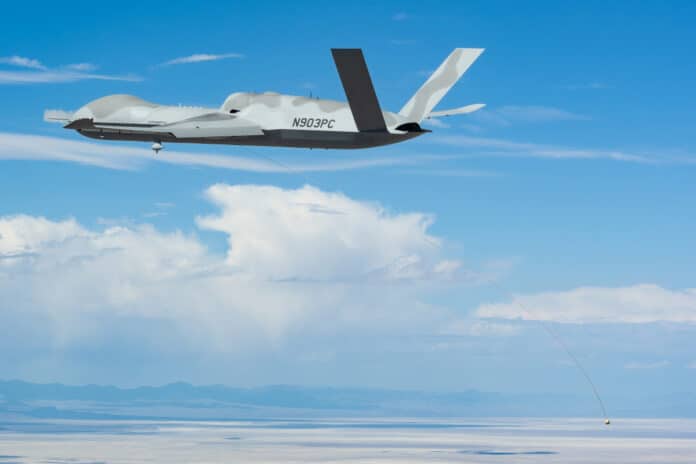In recent years, drones have played a crucial role in military operations, providing invaluable surveillance and striking capabilities. With advancements in technology, drones are becoming even more advanced and capable.
Using its MQ-20 Avenger Unmanned Aircraft System, General Atomics Aeronautical Systems (GA-ASI) has recently begun flight demonstrations of a new recovery system that will enable small drones to be launched and recovered in mid-air from larger uncrewed aerial vehicles.
The concept, which is called the Aerial Recovery System for Small Unmanned Aircraft Systems/Air-Launched Effects (SUAS/ALE), is part of a broader vision for how these types of aircraft might be used in future conflicts.
The system demonstration took place over the Dugway Proving Ground, Utah, on September 20, 2023. This saw a towline with a “smart end feature” deployed and retracted from the company’s larger Extended Range version of the jet-powered Avenger to capture smaller craft in flight.
During the demonstration, the General Atomics MQ-20 Avenger UAV integrated a hoist from Breeze-Eastern equipped with GA-ASI’s smart end feature into its payload bay. While in flight, the towline was deployed away from the Avenger to the optimal distance for aerial recovery, and the smart end feature wirelessly transmitted its position back to the aircraft. This confirmed its ability to transmit the data to a nearby SUAS/ALE for aerial recovery.
The smart end feature’s “deployed” position correlated to GA-ASI’s multi-degree-of-freedom finite element catenary models, confirming its potential for SUAS/ALE aerial recovery.
The smart end feature is not just a mechanical interface for aerial launch and recovery of a drone but also includes a beacon that provides cues on its location relative to the smaller drone. To elaborate, the SUAS/ALE drone can calculate its precise position relative to the smart end feature for navigation into towline intercept, followed by a maneuver to capture the end feature. When it is secured on the towline, the SUAS/ALE folds its wings and switches off its engine. It can then be reeled into the mothership drone using a podded hoist.
“Integrating air-launched UAS from Group 5 unmanned aircraft is possible, in part, thanks to advances in relative navigation technology, complex towline analysis, and multi-aircraft control being pioneered by GA-ASI,” said Mike Atwood, Vice President of Advanced Programs at GA-ASI. “We are excited to see this technology enable long-range kill chains from today’s manned and unmanned systems supporting operations in highly contested environments.”
The SUAS/ALE can be refueled, recharged, and rearmed, allowing it to be redeployed from the host aircraft. This feature enables SUAS/ALEs to conduct their own orbits from airborne launch and recovery positions instead of just being carried back to base.
Aerial redeployment allows UAS like GA-ASI’s Avenger or MQ-9A Reaper to serve as mobile command centers for a network of SUAS/ALEs in a persistent, expansive grid. Missions undertaken by these drone teams would include surveillance, electronic attack, enemy air defense suppression, communication pathways, or joint all-domain mobile command and control for days or even weeks at a time.
Breeze-Eastern’s commercial-off-the-shelf helicopter rescue hoists meet or exceed system requirements and provide a high Technology Readiness Level (TRL) while offering a low-risk solution to ensure SUAS/ALE aerial recovery. Throughout the hoist integration and flight testing, Breeze-Eastern provided technical and logistical support.
“With this milestone demonstration, GA-ASI has once again awed the aerospace industry. The professionalism and surgical ingenuity shown in the integration phase by the Aerial Recovery team all but guarantee future program success,” Ian Azeredo, Breeze-Eastern’s Chief Engineer, said in a statement.
